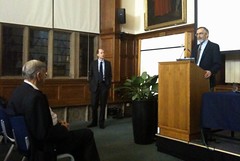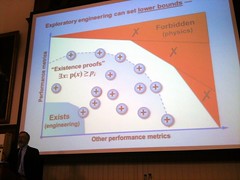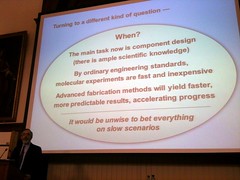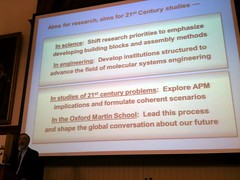November 13, 2011
Looking at the timeless landscape
 This Thursday Eric Drexler held the inaugural lecture for the Oxford Martin Programme on the Impacts of Future Technology. I am happy to be a research associate of the program.
This Thursday Eric Drexler held the inaugural lecture for the Oxford Martin Programme on the Impacts of Future Technology. I am happy to be a research associate of the program.
Eric's talk covered an important issue: how can we figure out things about technologies we have not built yet?
His answer is exploratory engineering. It has similarities both with science and engineering, but is distinct from both (just as they are distinct from each other).
Science aims at acquiring knowledge while normal engineering aims at providing products. Exploratory engineering aims at knowledge production. Normal engineering aims at manufacturing while exploratory engineering aims at valid modelling. However, this modelling is more like the modelling in engineering: reliable bounds are preferred over science's aim of exact beautiful descriptions, predictable behaviour is preferred over surprising discoveries, and having alternatives and parameters in the design is preferred over science's typical aim to exclude all alternatives to a theory.
While normal engineering produces detailed specifications for a design (since it has to be built) exploratory engineering contents itself with having a parametric model for the design (since what matters is the overall properties of the kind of design). Rather than aiming for robust products the goal is to get robust analyses. In particular, this means that in exploratory engineering one can use enormous margins in designs that would be uneconomical in a conventional engineering design since they both make the analysis easier and lowers the design/analysis costs.
The end result is a description of something that could exist and would have certain properties, not something that will exist. It is an existence proof showing what kind of things are possible. This way we can investigate what exists out there in the space of possibility, getting both an inkling about the potential of as-yet uninvented technologies. This can then be followed up with more careful modelling and strategizing, for example looking at pathways from our current capabilities towards desirable technologies. Or one can take the models as inputs to analysis of impacts - if a technology with *at least* these capabilities were around, what could be done?
An interesting problem is that while exploratory engineering can tell us plenty about the space of technological possibility, we do not have anything similar for science. We cannot know potential future sciences in the same way as we can know a potential technology, since we do not have any proper "physical theories" for the space of sciences. We know a bit about their sociology and history, but there is no way to rule out or bound an imagined science. This is bad news for investigations of issues that actually depend on the state of future science. The only way of finding out what is possible in science is to do it: unlike engineering it is opaque.
Changes in scientific knowledge is not an enormous problem for exploratory engineering - in this regard the landscape is indeed timeless. A new scientific discovery might change some of the shape of the boundary set by physical law, but since exploratory engineering anyway tends to use well-tested phenomena in a robust way this rarely impinges on them. A revolution in quantum gravity will not in the least change the performance metrics of macroscopic harmonic oscillators and hence designs relying on them will be unaffected. A surprise like superluminal communications might enable new technologies (a previously off-limits area in the diagram is now potentially accessible), but unless we have reliable examples of what can be done with it exploratory engineering cannot give us very deep insights.
Another issue is how to be "conservative". A conservative exploratory engineering design is something that has a very high likelihood of actually behaving like predicted if it was actually built in the real world. In analysing the future we are however interested in various loss functions: some impacts are good, others are bad. A useful heuristic is to assume fast technological change when looking for potential trouble, slow technological change when looking for potential benefits.
Atomically precise manufacturing (APM) is of course dear to Eric's heart. He sketched out some insights we have gained from exploratory engineering, normal engineering and current nanoscience. Overall the problem is that the different communities have little understanding of each other's needs: scientists are rewarded for discovering neat stuff but not for making it applicable, leading to a weakness of the transitional research that would lead to engineering. A stronger focus on discovering and inventing useful building-blocks would probably produce very useful results.
Posted by Anders3 at November 13, 2011 03:51 PM


